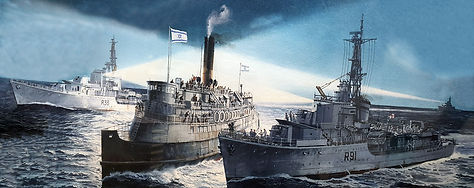EXODUS 1947
Summary – General Background
“Exodus 1947” is the story of the Clandestine Immigrants, the Jewish Holocaust survivors who clandestinely immigrated to Palestine despite the British Mandate’s restrictions. For the Clandestine Immigrants, this was a story which started at the end of World War II in 1945, and ended when the last Exodus passengers returned to Israel at the end of 1949.
When the Clandestine Immigrants tell their story, the actual journey on the Exodus 1947 and the battle against the British is only an 8 day chapter. Their story also includes memories of their parents’ homes, the Holocaust, the persecutions by the Nazis, the end of the war, the collection of the survivors by the various Zionist organizations throughout Europe to Training Centers operated by Brit Halutzim Datyim, HaPoel HaMizrahi, HaShomer HaTzair and others, preparing them for immigration to Israel.
As their story unfolds, the immigrants tell of crossing the European borders on foot, by car or by train, in the general direction of the American Occupation Zone in Germany, or to the Mediterranean shores of Italy and France.
As soon as the Illegal Immigration Foundation (Mossad Aliya Bet) informed the various Jewish organizations that a ship was ready to sail, thousands of Clandestine Immigrants were sent by train to temporary transfer camps to wait for the signal to board the ship. He voyage to Palestine lasted a week on average. Most ships were intercepted by the British, with or without a fight, and the immigrants were sent to incarceration camps at Atlit or in Cyprus. When the incarceration camps filled up, the British government decided on a new policy they called Refoulement (repulsion), meaning that the immigrants would be returned to their ports of origin. This policy was put in effect once only, on the passengers of the Exodus. This is the crucial difference between the story of the Exodus and the other Clandestine Immigrants who came to Palestine in those years. Their story had four added chapters:
-The journey on the prison deportation ships back to Europe.
-The resistance to disembarkation at Port de Bouc, France, at Gibraltar, and at Hamburg, Germany.
-Life at one or more Displaced Persons camps in Germany (Am Stau. Pöppendorf near Lübeck, Emden near Aurich, Sengwarden near Wilhelmshaven).
-After the United Nations partition plan for Palestine resolution of November 29,1947, to end the British Mandate and authorize the Jewish state, the Clandestine Immigrants returned to Israel during 1948-1949. Some of the Exodus immigrants came to Israel on the armaments ship Altalena sent by the Revisionist-National Military Organization. This ship was attacked and sunk by the Hagana near the Tel Aviv shores. Other immigrants boarded the ships Kedma, Ksarta and Theodor Herzl that sailed from Marseilles and other Mediterranean ports.
The task of locating the Holocaust survivors and organization of the clandestine immigration to Palestine, ruled at the time by the British
Mandate which opposed any large-scale Jewish immigration, required extra effort and organization from the various movements and political parties of the Jewish community of Palestiine.
Among the organizations active in this period were: The Jewish Agency (HaSochnut HaYeudit), the Illegal Immigration Foundation (Mossad Aliya
Bet), Hagana, PalYam, the Gideons, The Joint, etc. Each organization took upon itself a part of the national effort to bring the Holocaust survivors home.

The above painting shows the floodlit Exodus flanked by two British destroyers, after it was rammed by them at least once. The painting is “The Chosen One”, by the American painter Tom W. Freeman (1953-2015), drawn in watercolors in 1997 for the Exodus 50th year commemoration. The painting measures 57.6cm X 86.36 cm (23” X 34”).
Tom W. Freeman’s official intenet site is http://www.tomfreemanart.com/biography.html . Additional magnificent paintings of his may be found on this site, located by Google, and at https://goo.gl/cxQyRD .
